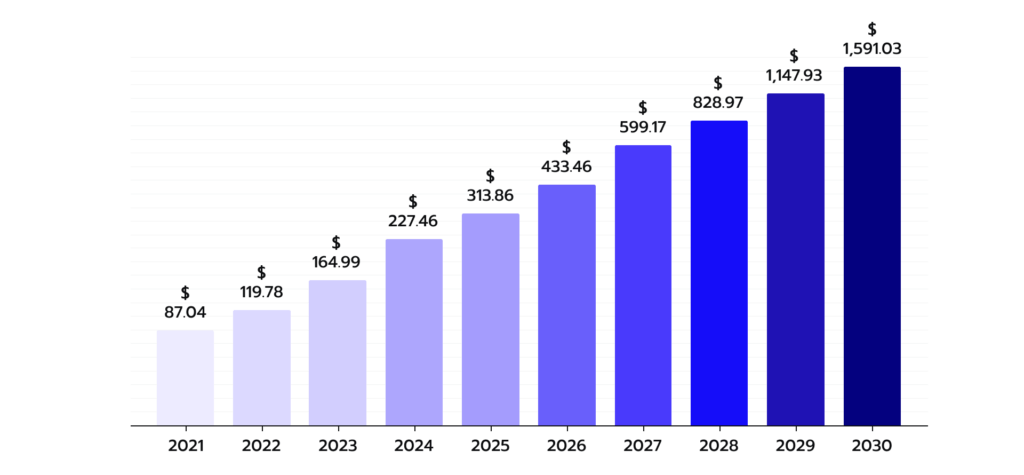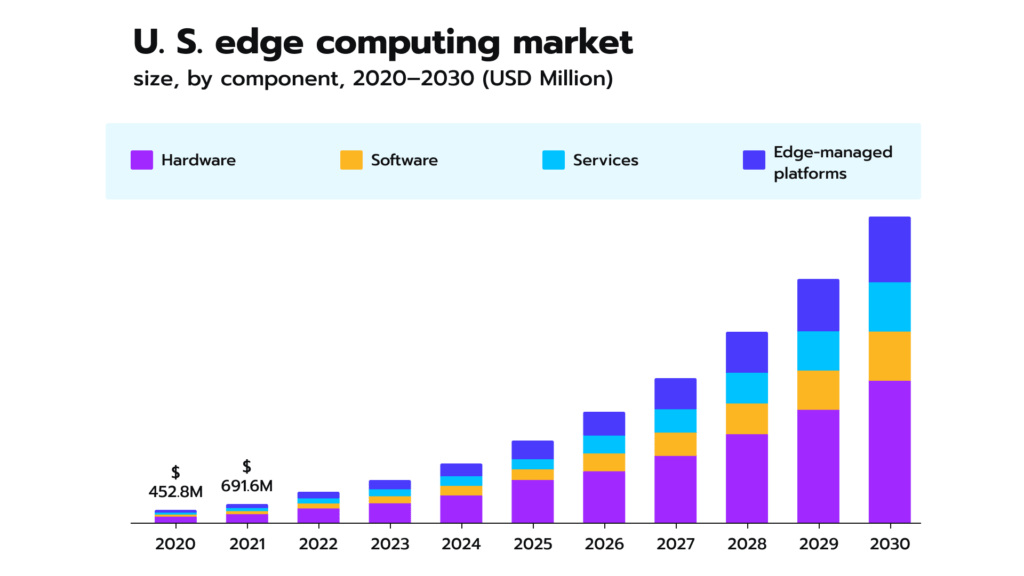Look into the most notable representatives of the Web 3.0 phenomenon and discover where its bright future lies.
The combined value of companies like Google, Amazon, and Meta is currently 500 times greater than the value of all Web 3.0 projects combined. What is more, Meta alone is worth $900 billion. Why does it matter? The businesses just mentioned are representatives of the Web 2.0 era. Yet, when researching the topic of Web 3.0, there is a definite indication that this technology is the future. Even though Web 2.0 has a far greater value than Web 3.0, this will soon change quickly.
For businesses, it means switching to Web 3.0 will quickly become inevitable. Businesses that consider and adopt Web 3.0 technologies will be among the first to gain the most competitive advantage in the future. Further, we’ll offer in-depth insights into Web 3.0 as the next evolutionary step of Web 1.0 and Web 2.0. Moreover, we’ll present the top ten most notable Web 3.0 technologies having the greatest business prospects.
What is Web 3.0?
Web 3.0 is a rising star. This report suggests the global venture capital investment in the most well-known Web 3.0 project is currently worth about $28 billion (see Fig.1). Figure 1. Global venture capital investment in cryptocurrency and blockchain
Figure 1. Global venture capital investment in cryptocurrency and blockchain
More important is the rate at which the Web 3.0 market value has increased. While in 2020, it was about $6 billion, however the market has expanded almost five times in the past two years.
But, what is Web 3.0 in the first place?
Simply put, it is the next evolutionary step in user-generated web technologies. It is a work-in-progress that you can hardly define with particular terms. For instance, while Web 2.0 climaxed with social networking technology, Web 3.0 is all about decentralization and eliminating third parties in the process of users interacting with the digital world. Web 3.0 introduces aspects that allow people to be free within the digital realm. Finally, the best explanation of Web 3.0 technologies can be brought through understanding its core principles.
Web 3.0 core principles
In a nutshell, the key idea behind Web 3.0 is to create a type of user experience that won’t be monitored, governed, and controlled at any point. There were dozens and hundreds of cases when Web 2.0 representatives like Meta and Google were accused of implementing algorithms to control user behaviors. In the Web 2.0 world, tech giants are the ones determining how a person interacts with the system and other users in the digital realm. Trying to deal with that, Web 3.0 technologies were founded on the following principles:
- Decentralization. This is the most important principle of Web 3.0. In Web 2.0, HTTP protocols were utilized by a user in finding the location of data stored on a particular server. In Web 3.0, the information can be found based on its specific content and it is stored across various locations, which brings decentralization. The approach breaks down massive databases held and manipulated by tech giants like Meta.
- Trustworthiness. Web 3.0 technologies are based on open-source software. They grant uninterrupted access to data and permit users direct interaction with one another without the necessity of having a trusted intermediary. Moreover, to participate in Web 3.0 technologies, one does not need a permit from any governing body.
- Connectivity. Within the Web 3.0 world, multiple applications can have immediate access. Further, the phenomenon makes the entire process ubiquitous. Considering the rise of the Internet of Things (IoT), one can expect more devices to be connected to the new system in the years to come.
With decentralization, trustworthiness, and connectivity, Web 3.0 moves users closer to what the Internet was supposed to be all about: the place where people can interact and access information without being governed, controlled, and manipulated.
Top 10 Web 3.0 technologies
While there are many examples of Web 3.0, the ones presented below have proved their value and are expected to transform into major Web 3.0 instruments in the near future. Yet, this list does not exhaust the available examples. The more businesses that will use Web 3.0, the faster the given list will expand.
1. Blockchain
Blockchain is a technology that allows peer-to-peer (P2P) transactions without needing clearance from any central authority. At the moment, blockchain is predominantly used for financial transactions. However, the use cases could be many. From a business standpoint, blockchain is the next evolutionary step in business optimization. As a collaborative Web 3.0 technology, blockchain eliminates the “cost of trust” factor, which offers a higher return on investment (ROI). More importantly, this Web 3.0 technology offers a next-level type of security. If there is any indication of tampering with the blockchain externally, the chain is broken automatically and the copies of the database scattered across the Internet. Binance, Coinbase, Gemini, Blockstream, and Solana are notable blockchain-based platforms.
2. Crypto
Crypto or cryptocurrency is a digital currency using top-grade encryption and safeguarding transactions. This instrument is based on blockchain technology. There is no need for any regulatory body or central issuing authority to complete crypto transactions. Blockchain is used to track down how much cryptocurrency is in circulation and who possesses it. Crypto is a digital entry, with each being linked to a certain online database. Cryptocurrencies are held in digital wallets and exchanged via crypto markets like Binance and Coinbase. New cryptocurrencies emerge monthly. Yet, the notable ones to mention are: Bitcoin (BTC), Ethereum (ETH), Polkadot (DOT), Solana (SOL), and Cardano (ADA). The current market cap for BTC alone is about $450 billion, which speaks volumes about the business value of this Web 3.0 technology.
3. Non-fungible tokens (NFTs)
A non-fungible token (NFTs) is a new form of digital art coupled with the phenomenon of digital assets. There has been massive interest in NFTs for several years and the interest will likely grow further (see Fig. 2). Figure 2. The US non-fungible token market
Figure 2. The US non-fungible token market
With the NFT market currently valued at about $5 billion, it is expected to increase manyfold by 2030. NFTs are digital representations of real-world art objects, including images, music, videos, and in-game items. NFTs are traded online, and often cryptocurrencies are used to pay for the transactions. Unique codes are imprinted into the asset to indicate ownership for a particular NFT. Here, you can find some of the most valuable NFTs, with prices reaching as high as $90 million per piece. NFTs are great investment assets and the price for many of these assets can rise dramatically over a matter of days.
4. Metaverse
One cannot speak about the metaverse as a single Web 3.0 technology. The term correlates to a general movement of how people interact and communicate with the technology based upon the Web 3.0 framework. Simply put, the metaverse is a concept offering integrated user experiences and communication via virtual reality (VR) and augmented reality (AR) tools. The metaverse mimics a natural social environment and offers users a high degree of embodiment on the web. While mimicking the real world, one can buy digital properties in the metaverse. Besides, there are almost limitless ways of user interaction within this technology. Some notable metaverses are the following: Second Life, Roblox, Pokemon Go, Fortnite, and Horizon. Metaverses can be used for business purposes, from improving communication to integrating companies into the digital world.
5. Semantic and spatial web
The semantic web is the Web 3.0 technology that allows better creating and sharing of material via search and analysis. Instead of keywords and numbers used in Web 2.0, the semantic web works with the meaning of single words. It grants a far greater accuracy of search results. The key idea behind the technology is to allow computers to have better tools for data modification on behalf of users.
In turn, the spatial web is about the integration of Convergence Technologies into a single device. The technology employs the power of AR, VR, Artificial Intelligence (AI), and Machine Learning (ML). Deloitte indicates that Spatial Web is a next-level user interaction with the web, while employing innovative computational methods to make the experience seamless. AR Cloud and 3D mapping are examples of the Spatial Web. These instruments allow users to interact with data in 3D via VR.
6. Artificial Intelligence (AI) and Machine Learning (ML)
Converse to popular belief, AI and ML are not modern technologies. First, AI was introduced in 1956, while the first iteration of ML was presented in 1959. However, with the emergence and the development of the web, AI and ML got a chance to show their true potential. These Web 3.0 technologies have made a huge leap from being worth $87 billion in 2021, and are expected to reach $1,5 trillion by 2030 (see Fig. 3). Figure 3. Artificial Intelligence market size in USD billion
Figure 3. Artificial Intelligence market size in USD billion
In simple terms, AI tries to mimic the way humans think, while ML uses data received in such a manner as to offer predictions. These algorithms are often used to predict what users want. AI and ML work with massive amounts of data in real-time. When thinking about AI and ML, consider Apple’s Siri. It is an intelligent agent using Natural Language Processing (NLP) to interact with users while mimicking human-type communication. With the power of AI and ML, computers in Web 3.0 can discern information in the same manner as humans do. There is a broad scope of application of AI and ML, including finance. Some notable platforms using AI and ML are: Netflix, Uber, Cortana, Siri, and Spotify.
7. Decentralized Autonomous Organizations (DAOs)
DAOs are used to collaborate with people. They are a powerful and secure tool that creates platforms owned by internet-native business associates. DAOs operate in the matter of joint ownership and governing. These organizations can have built-in treasuries that can be accessed only with the permission from the entire group. DAOs operate through in-group voting and decision-making to ensure everyone involved has a vote. Essentially, these organizations do not have a hierarchy of executive management. Every process within the DAOs is open, transparent, and democratic. Blockchain technology is used to ensure the security of DAO-based transactions. Importantly, with every transaction stored in a blockchain and open to public viewership, any type of fraud is practically impossible in DAOs. Some notable DAOs examples are DASH, MakerDAO, and Augur.
8. Decentralized applications
Any time you use Google Docs, you are utilizing a centralized application. This means that Google has full access to the documents’ data and can engage in any given manipulations without the need to ask your permission. In turn, decentralized apps grant you the benefit of cloud services without needing to adhere to any centralized authority. Often known as dApps, this Web 3.0 technology runs online computations through blockchain, most often Ethereum. While using peer-to-peer (P2P) networks, these apps can be used in various domains, including finance, gaming, and social media. Decentralized apps operate through users feeding, consuming, and seeding material in the same manner as torrent trackers. Some notable dApps to mention are 4G Capital, Etheria, and KYC-CHAIN.
9. Edge computing
Edge computing is another distinguished Web 3.0 technology. Grand View Research suggests that the compound annual growth rate (CAGR) for the U.S. edge computing market will grow 39% from 2022 to 2030 (see Fig. 3). Figure 4. The US edge computing market
Figure 4. The US edge computing market
This means the technology will bring billions of dollars to the companies that use it first. Edge computing is a paradigm focused on placing data processing as near as possible to the source of data to decrease latency and bandwidth use. It uses cloud services and brings the processing closer to users on their PCs and IoT devices. It is all done to reduce the number of long-distance transmissions between a user and a server. Additionally, edge computing allows for cutting out a middleman. It is delivered directly into a user’s local storage. Edge computing technologies include autonomous vehicles, smart cities, in-hospital patient monitoring, and cloud gaming.
10. Smart contracts
Last but not least, among the Web 3.0 technologies are smart contracts. A smart contract is a type of contract that includes all buyer-seller conditions translated into code. It is self-executed and all correlated lines of code are disseminated within decentralized blockchain technology. Smart contract transactions are easily traceable and are not reversible. Complex algorithms stand behind the execution process of this Web 3.0 technology. Smart contracts eliminate the factor of a central authority, external enforcement, and any given legal system. Often, the participants using these contracts are anonymous, and the transactions are trustworthy. This instrument brings legal transparency to a new level.
What will Web 4.0 be like?
All Web 3.0 technologies mentioned above can help aid your business. They grant new means of communication, security, and collaboration. In addition, crypto and NFTs can be used as great investment opportunities. Undoubtedly, Web 3.0 will bring billions and redefine how people do business. However, while Web 3.0 is the evolutionary step up from Web 2.0, one can only wonder what Web 4.0 will be like. We can expect that the next step in web development will be about Brain-Computer Interfaces (BCIs). This is a groundbreaking approach in nanotechnology that allows coupling the human brain with digital devices. Elon Musk founded Neuralink, a company that is working on making BCIs accessible to a broad public. In theory, BCIs can be used to control digital devices with the power of thinking.
Takeaways
IoT will likely bring digital devices into every aspect of our lives, AI and ML will offer immense computational power, BCIs will ensure control of our devices, and blockchain will offer high-grade security. However, until it happens, Web 3.0 technologies will be at the forefront of business transactions. This phenomenon is all about learning from past mistakes and making the web more user-centered. Moreover, Web 3.0 technologies improve transparency and security, which make any given business bulletproof to audits and data breaches.
If you want to know more about trends in edge computing, click here.
If you want Avenga to help you with Web 3.0 adoption in finance or other industries, feel free to contact us.


 Figure 1
Figure 1 Figure 2.
Figure 2.  Figure 3.
Figure 3.  Figure 4.
Figure 4. 






